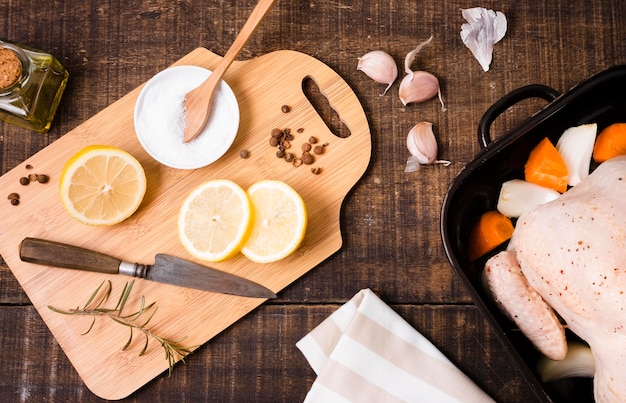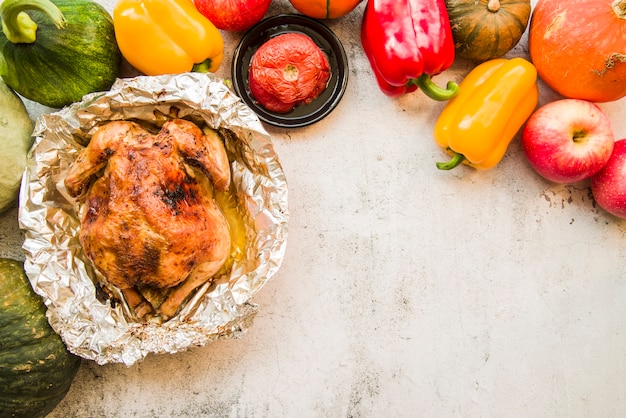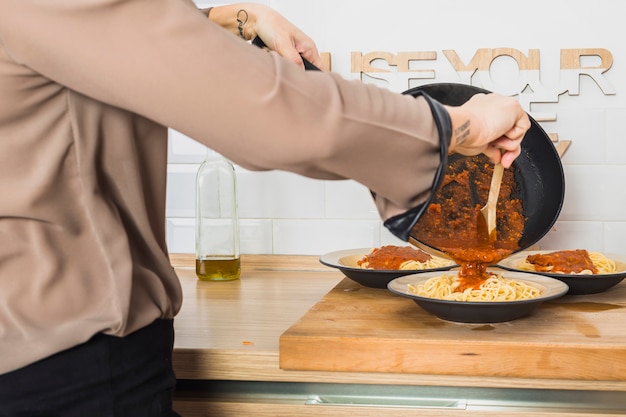Ah, the roast chicken. It’s a culinary classic, a Sunday dinner staple, and a dish that never fails to bring a warm, comforting feeling to any table. There’s something truly satisfying about the golden-brown skin, the succulent meat, and the tantalising aroma that fills the kitchen. But how do you get that perfect roast chicken, you know, the kind that makes everyone go “mmmmm”? That’s where I come in. Over the years, I’ve experimented in my kitchen, tried different techniques, and learned a few things about roasting a chicken that make all the difference. So, grab your apron, gather your ingredients, and let’s get cooking!
(Part 1) The Foundation: Choosing and Prepping Your Bird

Let’s start at the beginning, with choosing the right chicken. You've got a few choices: free-range, organic, or the standard supermarket chicken. Now, I'm a big believer in free-range chickens. They roam around, get some sunshine, and that translates into a more flavourful bird. But, if you're on a budget, don’t worry, a regular supermarket chicken will do just fine.
Size Matters: Picking the Perfect Weight
Next, size matters. For a family of four, a 1.5kg chicken is a good starting point. If it’s just you and your partner, a smaller chicken, around 1kg, will be plenty. Don’t worry if it's a bit smaller or bigger, you can adjust the cooking time accordingly.
Thawing a frozen chicken: The Right Way
Now, if you’ve got a frozen chicken, you need to thaw it properly. No one wants a chicken that’s still got a bit of ice in it, right? The best way is to put it in the fridge overnight. It takes about 12 hours to thaw completely, but trust me, it’s worth the wait. You can also thaw it in cold water, but change the water every 30 minutes to keep it cold. And never, ever thaw a chicken at room temperature. It’s a big no-no for food safety.
Gathering Your Equipment
Before we get to the actual roasting, let’s make sure you’ve got the right tools. A roasting tin is a must-have – big enough to comfortably fit your chicken. I personally love using a cast iron pan; it helps to get that lovely crispy skin. And don't forget a meat thermometer, essential for making sure the chicken is cooked through. Safety first, always!
(Part 2) Prepping Your Chicken: Getting Ready for the Oven

Alright, now for the fun part – prepping the chicken. It's a simple process, but a few little steps make a big difference.
Drying Out the Moisture
The first step is to pat the chicken dry with kitchen paper. A wet chicken won’t brown as nicely in the oven. It's a simple tip, but it makes a difference.
Salt and Pepper: The Basics of Seasoning
Next, season it generously with salt and pepper – you can never have too much when it comes to roast chicken. I always use a good quality sea salt and freshly ground black pepper for maximum flavour.
Stuffing: A Matter of Personal Choice
Now, stuffing is a bit of a personal preference, isn’t it? Some people swear by it, others think it’s unnecessary. If you’re going for the classic roast chicken, a sage and onion stuffing is a classic choice. But if you want to experiment, you could try a breadcrumb stuffing with herbs, or even a fruity stuffing with cranberries and apricots.
If you're stuffing your chicken, remember to stuff it loosely – don’t pack it in too tightly or the chicken won't cook evenly.
Tying It Up and Tucking It In
Time to tie those legs together. Use kitchen string or butcher’s twine to keep the chicken compact. This helps it cook evenly and prevents the legs from drying out.
Finally, tuck the wings behind the chicken – it might sound a bit fiddly, but it helps them cook more evenly.
(Part 3) Into the Oven: Roasting the Perfect Bird

Your chicken is all prepped, ready to go. Now, let’s get that bird in the oven!
Setting the Right Temperature
First, preheat your oven to 200°C (400°F) – a good starting point for a crispy skin.
Estimating the roasting time
Now, the cooking time will vary depending on the size of your chicken. Here’s a rough guide to give you an idea:
| Weight of Chicken | Cooking Time |
|---|---|
| 1kg | 1 hour |
| 1.5kg | 1 hour 30 minutes |
| 2kg | 2 hours |
But, remember, it's always best to use a meat thermometer to check if the chicken is cooked through.
The Meat Thermometer: Your Cooking Companion
Insert the thermometer into the thickest part of the thigh, making sure it doesn't touch any bone. The chicken is cooked through when the thermometer registers 74°C (165°F). undercooked chicken is a big no-no, so be sure to cook it thoroughly.
(Part 4) The Art of Basting: Adding Moisture and Flavour
While the chicken is roasting, you can give it a little TLC by basting it. It’s a simple step, but it makes a big difference in keeping the chicken moist and adding a beautiful glaze to the skin.
The Simple Basting Technique
Simply take some of the juices that have collected in the roasting tin and spoon it over the chicken. It’s that easy!
How Often to Baste
You don’t need to baste it constantly. Basting every 30 minutes or so is enough to keep the chicken juicy and flavourful.
(Part 5) The Resting Period: A Crucial Step for Juicy Meat
Once the chicken is cooked, don't be tempted to carve it right away. Let it rest for 10-15 minutes before you carve it. This allows the juices to redistribute throughout the meat, resulting in a more succulent and juicy chicken.
Covering the Chicken
Cover the chicken loosely with foil to keep it warm while it rests.
(Part 6) Carving It Up: The Final Touches
And now, the moment of truth! It’s time to carve up that gorgeous chicken.
The Carving Technique: Simple and Effective
First, remove the legs and thighs. Then, carve the breast into slices.
Serving it Up: A Feast for the Eyes and Palate
Serve the chicken with your favourite sides, like roasted potatoes, green beans, or gravy.
(Part 7) Tips and Tricks from My Kitchen: Elevating Your Roast Chicken
Over the years, I’ve picked up a few tips and tricks that have helped me roast the perfect chicken. Here are a few of my favourites:
1. Brining: Adding Moisture and Flavour
Brining is a great way to add extra flavour and moisture to your chicken. Simply soak the chicken in a salt water solution for a few hours before roasting. This helps draw out moisture and create a more tender and juicy chicken.
2. The Power of Herbs: Aromatic Delights
Don't be afraid to get creative with your herbs! I love using rosemary, thyme, and sage. But you can also try parsley, oregano, or even lavender.
3. Roasted Vegetables: A Perfect side dish
Add some chopped vegetables to the roasting tin – potatoes, carrots, onions – and let them roast alongside the chicken. They’ll absorb all the lovely flavours from the chicken and create a delicious side dish.
4. The "Bird Bath" for Crispy Skin: A Simple Technique
Want extra-crispy skin? Give your chicken a "bird bath" before roasting. Simply rinse it under cold water, pat it dry with kitchen paper, then rub it with a little oil. This helps create a beautifully golden-brown skin.
5. Leftover Love: Maximising Your Meal
Leftover chicken? Don't despair. You can make a delicious chicken salad, a creamy chicken soup, or even chicken sandwiches.
(Part 8) FAQ: Your Roast Chicken Questions Answered
1. How do I know if my chicken is cooked?
Use a meat thermometer to check that the chicken has reached 74°C (165°F) in the thickest part of the thigh. If you don’t have a thermometer, you can check that the juices run clear when you pierce the chicken with a knife.
2. What if my chicken is a bit dry?
Basting your chicken regularly can help keep it moist. Adding a little bit of butter or oil to the roasting tin can also help.
3. Can I freeze a roasted chicken?
Yes, you can freeze cooked chicken for up to 3 months. Just wrap it tightly in cling film or foil and store it in the freezer.
4. How do I make crispy chicken skin?
Pat the chicken dry before roasting and roast it at a high temperature – 200°C (400°F). You can also rub the skin with a little oil or butter before roasting.
5. What should I serve with my roast chicken?
Roasted chicken goes well with a variety of side dishes. Some popular choices include roasted vegetables, mashed potatoes, gravy, stuffing, and salads.
And there you have it, your comprehensive guide to roasting a perfect chicken. Follow these tips and tricks, and you’ll be whipping up delicious roast chicken dinners in no time. Happy cooking!
Everyone is watching

Corn on the Cob: The Ultimate Guide to Perfectly Cooked Ears
Healthy MealsAh, corn on the cob. Just the name evokes images of sunny days, barbecues, and that sweet, juicy flavour that ...

Perfect Pork Roast Oven Cooking Time: A Guide to Delicious Results
Healthy MealsThere's something truly satisfying about a perfectly roasted pork. The aroma alone is enough to make your mout...

Scallops: The Ultimate Guide to Perfect Cooking
Healthy MealsAh, scallops. Those delicate, sweet, and utterly delicious morsels of the sea. They hold a special place in my...

Ham Cooking Time: How Long to Bake, Smoke, or Boil a Delicious Ham
Healthy MealsAh, ham. It's a classic, isn't it? A real crowd-pleaser, especially around holidays. And when done right, it'...

Spaghetti Squash: The Ultimate Guide to Cooking and Serving
Healthy MealsRemember that time you saw spaghetti squash at the supermarket, looking all bumpy and strange, and thought, "W...
